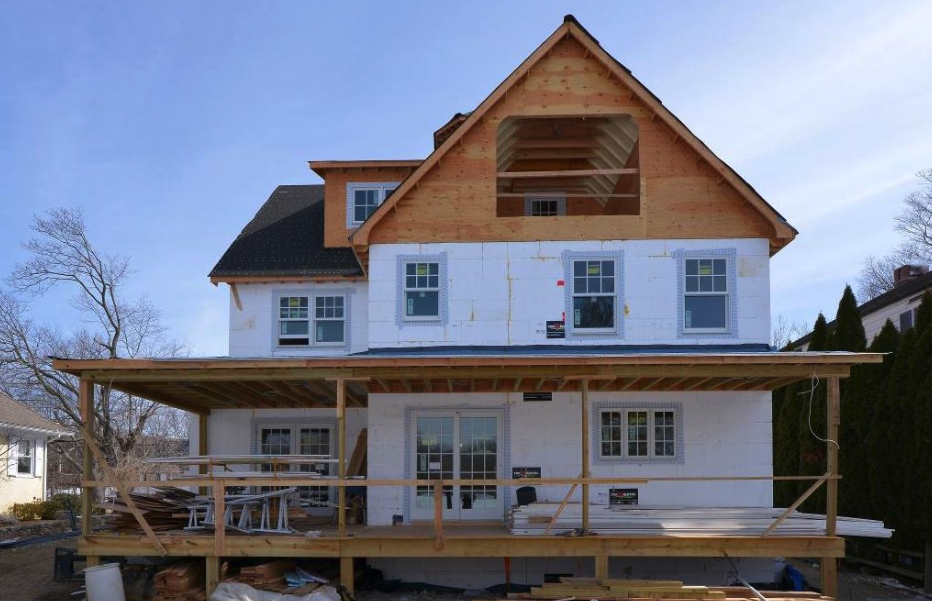
The Best Roofing Options for ICF Homes

Like Fox Blocks insulated concrete form (ICF) walls, ICF roof construction (including the roofing shingles, sheathing, and framing), must protect a home and its occupants from increasingly severe and unpredictable weather events. The best roof for ICF houses will need to contribute to a strong continuous load path that will manage the wind energy or forces and hold the house together during dangerous winds of over 100 miles per hour (mph).
In addition, an ICF roof must resist flying debris that can penetrate the roof, diminishing its integrity which can cause complete roof collapse. Home failures often start with roof damage during intense tornado and hurricane winds.
Wind-Resistant ICF Wall Systems

ICFs contribute to a strong continuous path by providing shear walls with the structural capacity and stiffness to resist the in-plane forces from severe winds of over 200 mph and flying debris over 100 mph — significantly better than wood- or steel-framed walls. ICF wall strength also reduces the lateral twists and damage to non-structural elements of a house, like plumbing and electrical.
ICF construction can effectively maintain a home's wall integrity during an intense wind event. However, the roof must also provide sufficient durability to ensure severe winds will not rip it from the house, exposing and seriously damaging the home's interior.

Why ICF Homes Need Durable Roofing
In 2013, an EF5 tornado hit Oklahoma City with 210 mph winds, destroying 1,150 homes and causing 23 deaths. Two ICF homes in the tornado's path survived. Reward Wall Systems, a subsidiary of Fox Blocks, built both houses.
Unfortunately, the homes' walls stayed intact, but both houses lost their roofs, allowing for significant damage to the interiors. Fortunately, both houses had ICF safe rooms with concrete roofs that protected the occupants during the treacherous wind event.
ICF Roofing Systems
Strong winds blowing over the roof's edge can produce a vacuum and uplifting pressure that can tear a roof off, and flying debris can damage the roof's integrity. Therefore, the ICF roofing must include durable sheathing and adequate framing to move the wind's loads to the below-supporting shear walls as part of the continuous load path. The roof system should also include roofing materials, like Brava's composite roofing tiles, that protect the sheathing from wind, hail, and debris.
You can find the requirements for roof systems in Chapter 15 of the IBC, Chapter 7 of the IEBC, and Chapter 9 of the IRC.
Roof Sheathing
In regions that experience wind speeds of less than 100 mph, FEMA allows the use of common nails to connect roof sheathing to supporting components. In higher-wind areas, FEMA requires ring-shank nails. However, spaces prone to significant uplifts, like corner zones, eaves, and roof areas, require wood nails.
Roof Framing
As part of the load path of a house, the lateral loads move from the roof to the roof framing, then shear walls. Therefore, the roof frame's rafter size must withstand the weight of the roof system and the loads produced by wind.
In high wind areas, for the connection of the roof framing system, high wind designed metal connectors may be cast into the ICF concrete along the top of the wall, securing the roof framing to the wall assembly.
Wind-Resistant Roofing Material

Class 4 shingles offer the highest resistance against severe winds, hail, and flying debris, to protect the roofing sheathing and framing, and ultimately the house's structural integrity.
Class 4 shingles include asphalt, metal, wood, and slate; however, all have significant problems. For example, asphalt shingles will shed their protective granules, metal roofing is easily dented, wood requires a great deal of maintenance, and slate is exceptionally costly and heavy.
Fortunately, Class 4 impact-resistant composite roofing tiles from Brava provide a modern approach to protecting your roof structure from damaging wind and hail. Lightweight and easy-to-install Brava tiles are an available and long-lasting solution to wind- and impact-resistant roofing materials.
Furthermore, Brava makes their composite roof shingles in the USA from recycled products and they are available in several in-demand roofing tile designs.
Synthetic Slate

Brava's Old World Slate tile has the beauty and luxury of natural slate without expensive maintenance and additional roof support.
Synthetic Cedar Shakes
Brava's Cedar Shake composite tile provides the classic look of natural cedar and the peace of mind that the shingles won't rot, warp, or crack. To achieve the look of natural rough-cut cedar shakes, Brava offers the tiles in three different widths.
Synthetic Clay

Brava's Barrel tile (a composite Spanish roof tile) creates the elegance of a Mediterranean villa without the added weight and installation cost of natural clay. In addition, barrel roof tiles do not absorb water, which means they will not crack or break if exposed to repeated freeze-thaw cycles, like regular clay tiles.
The Best Roofing Options for Fox Blocks ICF Homes

Fox Blocks ICF wall systems resist dangerous winds and flying debris, and contribute significantly to the continuous load path required to protect a house against destructive tornadoes or hurricanes. However, to protect the house's interior, the design of a wind-resistant home must also include a wind- and impact-resistant roofing system. The roofing materials, sheathing, and framing must be able to withstand intense winds, in order to pass the loads down to the ICF shear walls.
Don't hesitate to contact the professionals at Fox Blocks today for more on roofing options for ICF homes. For more detailed information search the Resource Library on the Fox Blocks website.